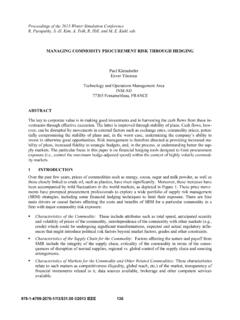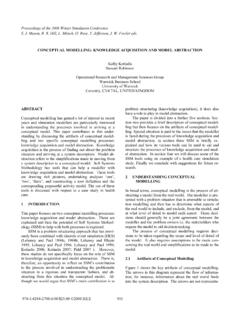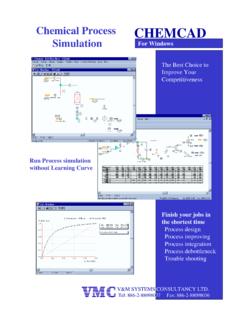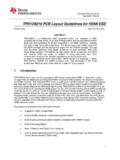Transcription of MODELING PCB ASSEMBLY LINES IN EMS …
1 Proceedings of the 2011 Winter simulation Conference S. Jain, Creasey, J. Himmelspach, White, and M. Fu, eds. MODELING PCB ASSEMBLY LINES IN EMS PROVIDER S ENVIRONMENT: INTEGRATING PRODUCT DESIGN INTO simulation MODELS Jing Li Nagen Nagarur TE Connectivity Binghamton University 301 Constitution Drive 4400 Vestal Parkway East Menlo Park, CA, USA Vestal, NY, USA Krishnaswami Srihari Binghamton University 4400 Vestal Parkway East Vestal, NY, USA ABSTRACT The manufacturing pattern of most Electronic Manufacturing Services (EMS) suppliers in US has trans-formed to accommodate a high mix and low volume environment. Printed Circuit Board (PCB) ASSEMBLY at EMS is characterized as product oriented production : based on product designs, assemblies are pro-cessed with different routings, while operation times and process yields also vary depending on the com-plexity of products.
2 Therefore, in order to simulate PCB ASSEMBLY line , it is necessary to combine design information into simulation models. This research endeavor is focused on integrating design factors into a planning system, which is developed based on Discrete Event simulation (DES) MODELING . By applying this proposed system, EMS suppliers can effectively plan the required manufacturing resources, predict production cycle time and optimize resource deployment for a specific product. This architecture can significantly reduce the uncertainties of predictions that are caused by product mixes and provide custom-ized production profile for individual product. 1 INTRODUCTION Due to the nature of contract manufacturing, most EMS production can be described as high mix and low to medium volume (Ramakrishnan, Parimoo, and Srihari 2005). EMS suppliers need to achieve two key goals: (i) meeting the delivery commitment to customers, and (ii) reducing production cost by enhancing the utilization of resources (Ramakrishnan, Parimoo, and Srihari 2005; Sivakumar et al.)
3 2004). In order to achieve these goals, careful production planning should be carried out for each batch of products. For in-stance, production lead time should be estimated ahead of time for the purpose of determining the order and date to launch new products; resource allocation should be optimized in order to enhance the utiliza-tion of both equipment and labor resources. Since the PCB ASSEMBLY process consists of a large number of process steps, random machine failures and resource constraints, commercial software such as Enterprise Resource Planning (ERP) systems or other analytical models based on static calculation have limited ability of providing realistic solutions for day-to-day production processes. MODELING and simulation , on the other hand, can explicitly capture these dynamic impacts and is applied as a principle methodology for analyzing and MODELING PCB ASSEMBLY LINES (Diwe et al.
4 2002; Potoradi, Mason, and Fowler 2002). 2341978-1-4577-2109-0/11/$ 2011 IEEELi, Nagarur, and Srihari Many research endeavors have been carried out to model PCB ASSEMBLY line and also aim to address some unique features of PCB ASSEMBLY production, such as resource constraints during production, im-pacts of labor activities, and frequent machine failures, etc. (Mukkamala, Smith, and Valenzuela 2003; Seppanen 2005). However, one of the most significant characteristics of PCB ASSEMBLY production has been overlooked product oriented production. For PCB ASSEMBLY production, production plan needs to be generated according to a specific product, because different products can be quite different in terms of manufacturing resource requirements and production lead time (Srihari and Emerson 1990). Product de-signs define the whole manufacturing processes and basically determine production routings, operation times and process yields.
5 Neglecting the differences of products in a planning system would significantly undermine the accuracy of predicted results. Essentially, a simulation model with fixed configurations and parameter settings (operation times and yields) is difficult or impossible to fit the scenario of high va-riety of products unless assuming that all the products are the same. This research endeavor focuses on developing a prototype production planning system based on DES MODELING that is applied in PCB ASSEMBLY domain. The main objective of this study is to develop a system in order to combine product designs with a simulation model and make it adjustable for different prod-ucts. Based on this system, EMS suppliers can efficiently allocate the required manufacturing resources, predict production cycle time and optimize resource deployment for a specific product.
6 2 BACKGROUND At an EMS provider, when a new order is placed, product information, including batch size, Computer Aided Design (CAD) files, Gerber files, Bill of Materials (BOM), and ASSEMBLY process requirements, is provided by the customers. According to ASSEMBLY information and customer requirements, manufactur-ing engineers can determine process flow and work contents at each workstation. Production routings and work contents are determined principally based on product design and additional customer requirements. For example, according to CAD data, engineers can decide whether this product needs single-side or dou-ble-side surface mount ASSEMBLY , and determine whether wave soldering or press-fit operations are re-quired depending on through-hole component types. As shown in Figure 1, based on designs, products are processed in different workstations with different yields and operation times.
7 Figure 1: Production depends on ASSEMBLY designs 2342Li, Nagarur, and Srihari In terms of configuration of a system, since it is impractical to build individual model for each prod-uct, a simulation model developed for an EMS facility should be able to be adjustable correspondingly to accommodate defined routings. A planning system developed for PCB ASSEMBLY production must have the capability to identify the required machines and ASSEMBLY LINES , and re-connect all of the selected re-sources to be a customized configuration for a specific product. Moreover, operation times and process yields at each work station are also highly dependent on prod-uct design (Zhou and Ladhar 2001, Tarhalkar and Srihari 2002). Typically, in the literature, simulation models are generated according to a standard routine: in order to determine parameter settings for each operation module, data is either extracted from historical databases of production line under considera-tion, or by performing time studies during actual manufacturing process.
8 Data, once collected, is fit to a distribution and applied as parameter settings in simulation models. There is no doubt that the models generated in this way can be used to represent a manufacturing system to certain extent, and can be ap-plied for long-term planning purpose. However, when the objective focuses on particular short-term plan-ning goals and the planning system is principally used for guiding daily production by providing a specif-ic manufacturing profile for each product, the inputs that are only based on the general features of a line are not sufficient, especially for PCB ASSEMBLY manufacturing. In terms of operation time, most of the machines of a PCB ASSEMBLY line are precisely controlled with standard operation time. For instance, considering a placement workstation, Product A includes 1000 sur-face mount components that need to be populated on a circuit board, while product B has only 200 com-ponents to be mounted.
9 Each single placement takes a fixed amount of time. Thus, the placement time can be precisely calculated with the information of component types and quantity. If a simulation model is applied without re-initializing the settings of operation time according to this particular product, predic-tion results might show that product A takes almost the same or even less processing time compared with product B, which is obviously wrong. Additionally, machine time is highly correlated with component types. Placing a fine pitch integrated circuits (IC) component takes a longer time than a normal compo-nent, and also placing a high I/O Ball Grid Array (BGA) needs much more time than a passive compo-nent. Neglecting the design factors and adopting a randomly generated value following certain distribu-tions, the machine time or cycle time could be far from the reality.
10 Similarly, yield at each workstation is also highly dependent on product design. The general rule is that increased component complexity increases the chances of defects (Tong 2001). For example, the de-fect rate of a chip shooter to place 0603 components is as low as 0%, the defect rate averages around 10% to place 0402 components, and the defect rate could increase to 50% when placing 0201 components. In this case, the defect rate increases due to a reduction in component size, which requires higher placement accuracy. Thus, using the same machine but placing components with a smaller size can result in more is-sues and defects. At each operation step, products with defects have to be reworked before being trans-ported to the next workstation. Rework is a time-consuming operation and significantly impacts the pro-duction lead time.












